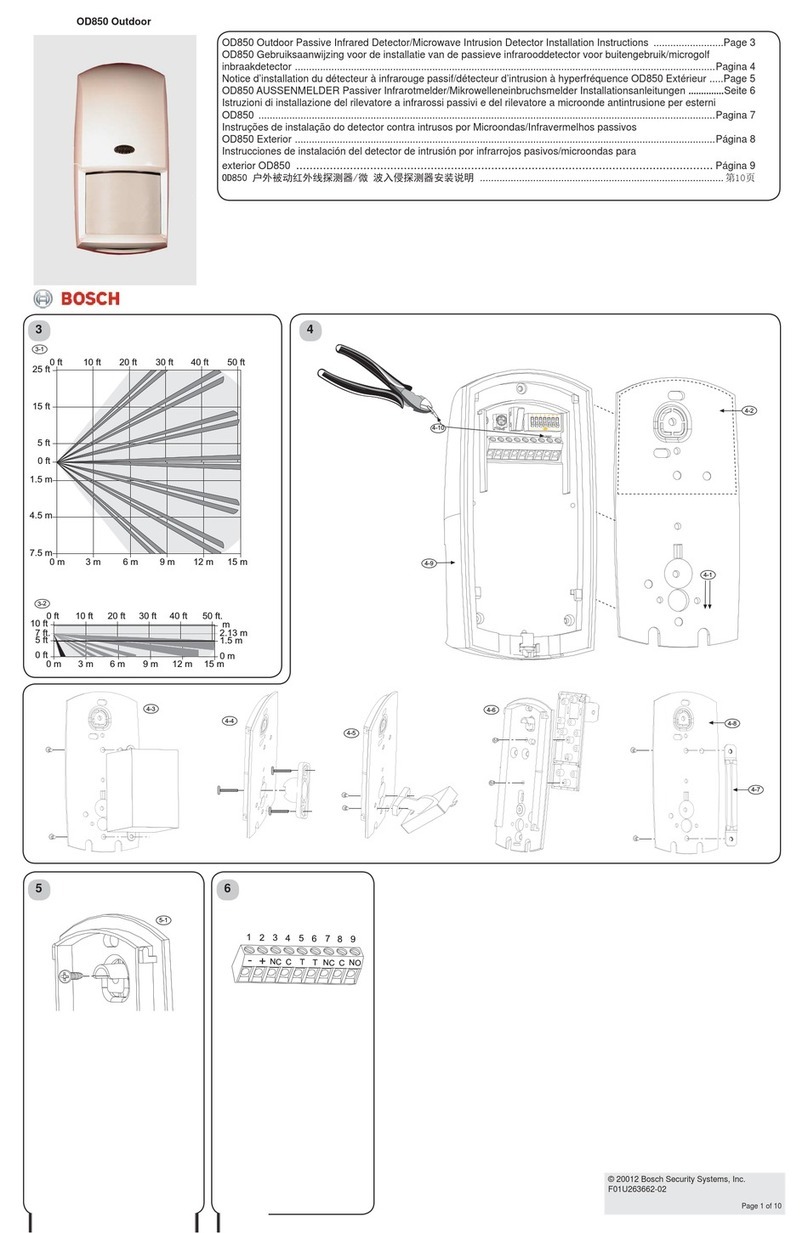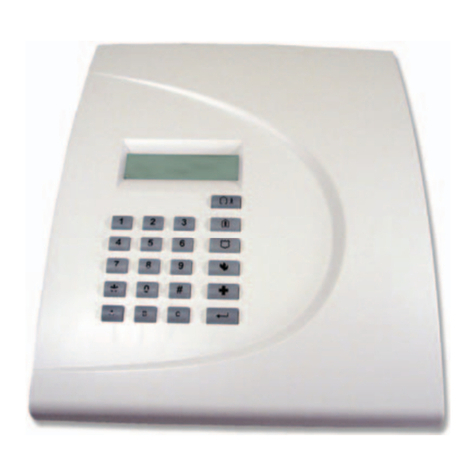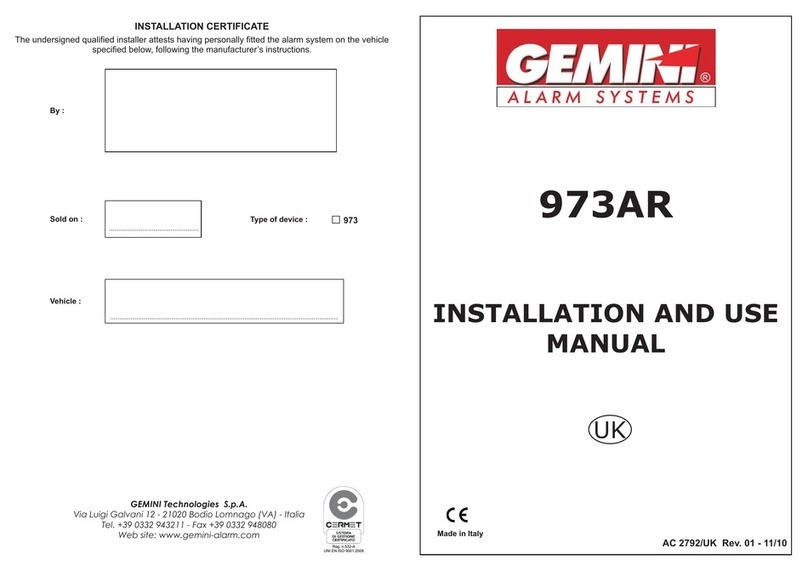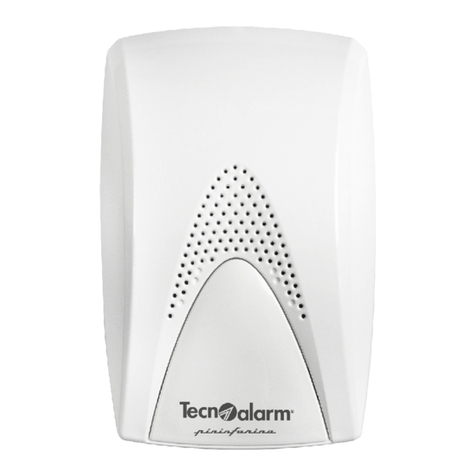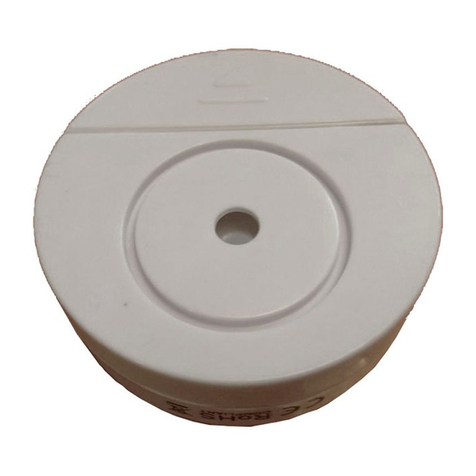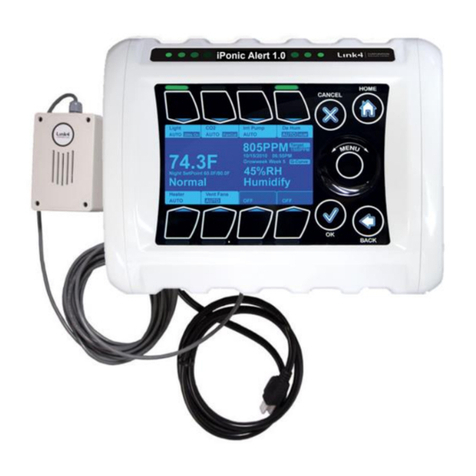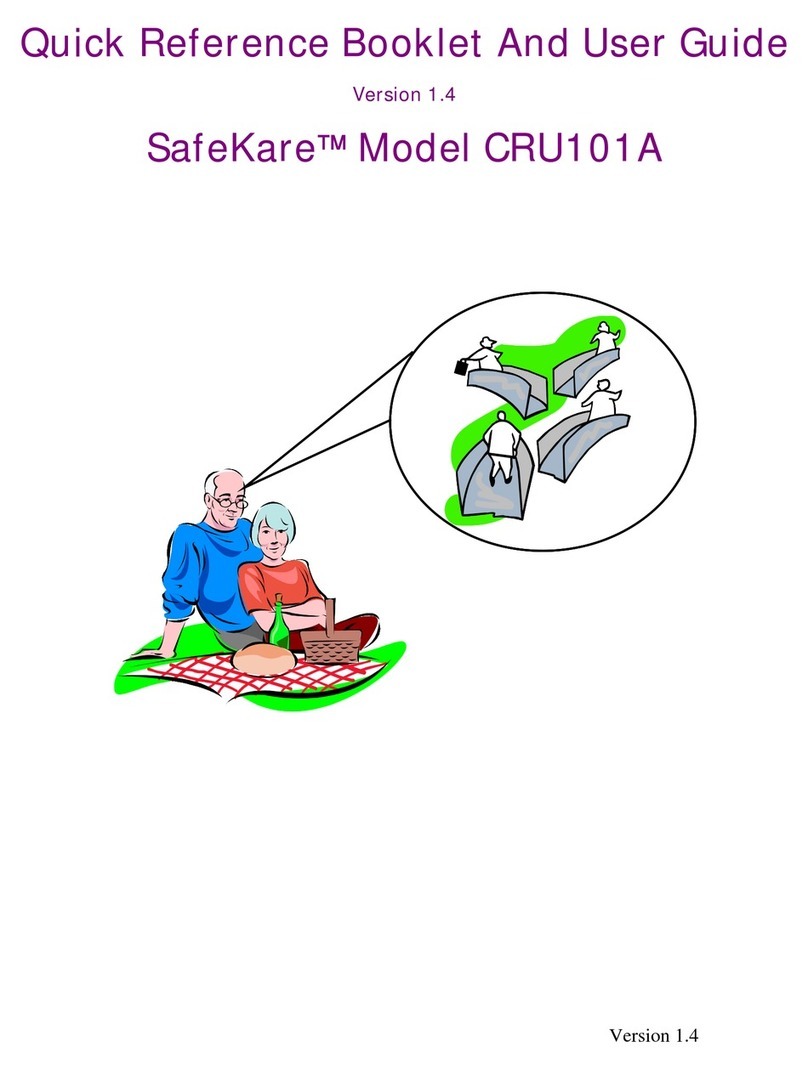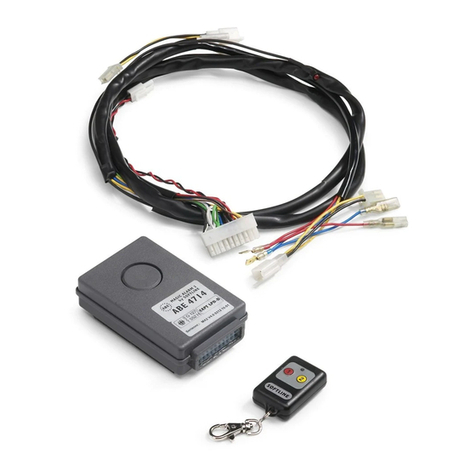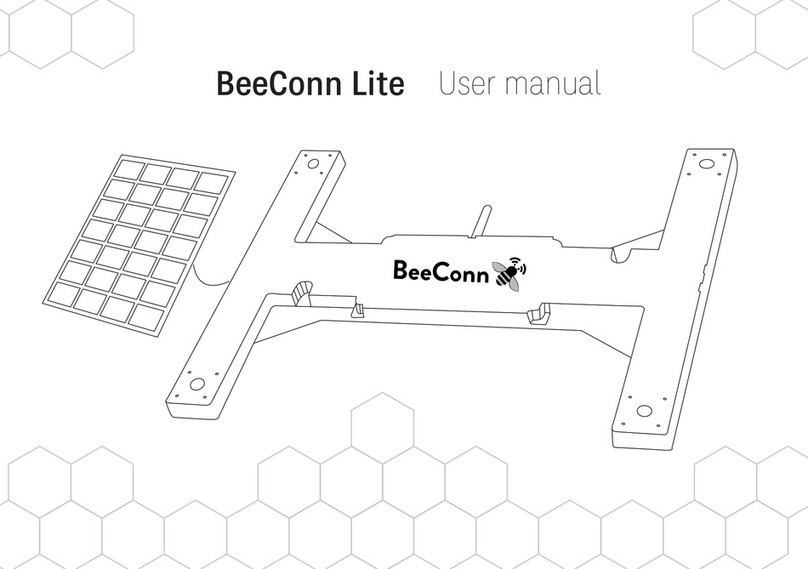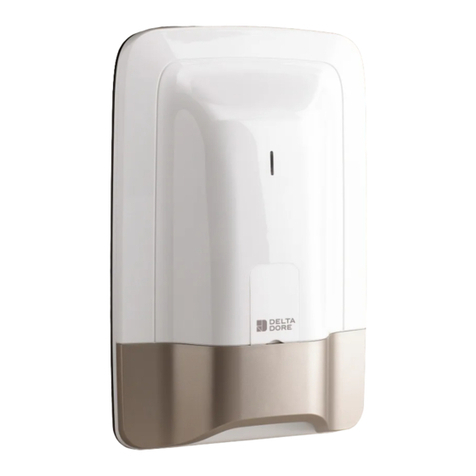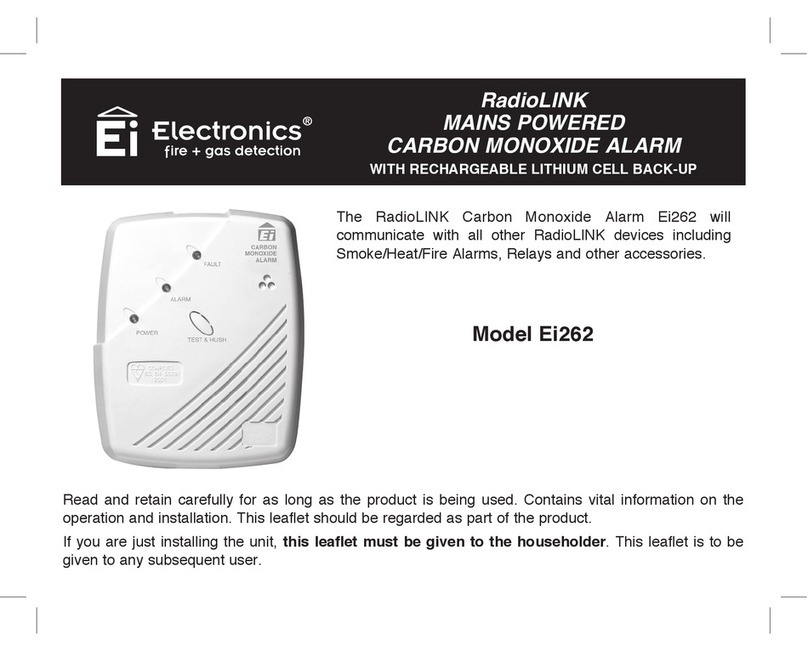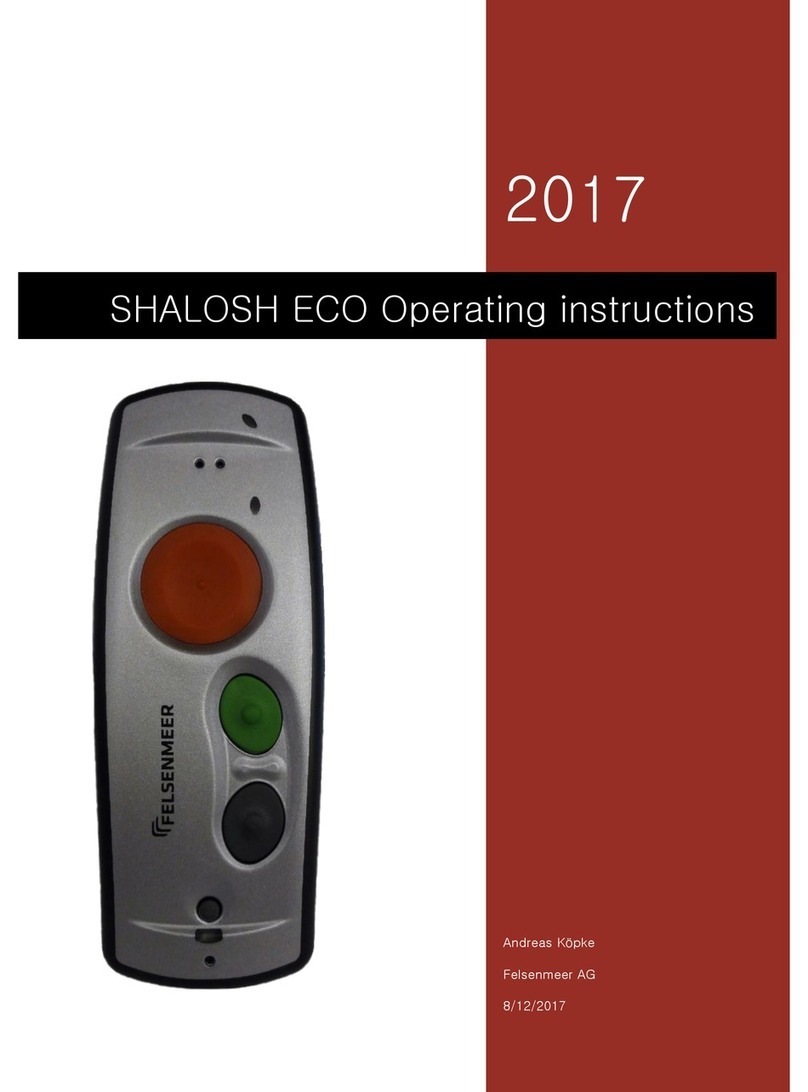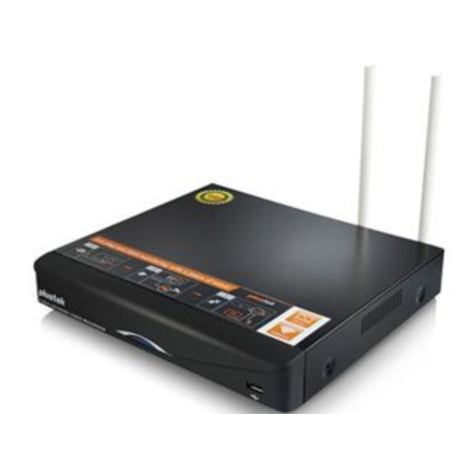Bosch LTC 5136/61 User manual

LTC 5136 Series
Instruction Manual
EN AutoDome®Controller

LTC 5136 Series | Instruction Manual | Important Safeguards
Bosch Security Systems | 04 September 2003
EN |2
Important Safeguards
1. Read Instructions - All safety and operating
instructions should be read before the unit is
operated.
2. Retain Instructions - The safety and operating
instructions should be retained for future reference.
3. Heed Warnings - All warnings on the unit and in
the operating instructions should be adhered to.
4. Follow Instructions - All operating and use
instructions should be followed.
5. Cleaning - Unplug the unit from the outlet before
cleaning. Do not use liquid cleaners or aerosol
cleaners. Use a damp cloth for cleaning.
6. Attachments - Do not use attachments not
recommended by the product manufacturer as they
may cause hazards.
7. Water and Moisture - Do not use this unit near
water - for example, in a wet basement, near a
swimming pool, in an unprotected outdoor
installation, or in any area classified as a wet
location.
8. Accessories - Do not place this unit on an unstable
stand, tripod, bracket, or mount. The unit may fall,
causing serious injury to a person and serious
damage to the unit. Use only with a stand, tripod,
bracket, or mount recommended by the
manufacturer or sold with the product. Any
mounting of the unit should follow the
manufacturer's instructions and should use a
mounting accessory recommended by the
manufacturer.
An appliance and cart combination should
be moved with care. Quick stops, excessive
force, and uneven surfaces may cause the
appliance and cart combination to overturn.
9. Ventilation - This unit should not be placed in a
built-in installation or rack, unless proper
ventilation is provided, or the manufacturer’s
instructions have been adhered to. The equipment
must not exceed its maximum operating
temperature requirements.
10.Power Sources - This unit should be operated only
from the type of power source indicated on the
marking label. If you are not sure of the type of
power supply you plan to use, consult your dealer
or local power company. For units intended to
operate from battery power or other sources, refer
to the operating instructions.
11. Grounding or Polarization - This unit may be
equipped with a polarized alternating-current line
plug (a plug having one blade wider than the
other). This plug will fit into the power outlet only
one way. This is a safety feature. If you are unable
to insert the plug fully into the outlet, try reversing
the plug. If the plug should still fail to fit, contact
your electrician to replace your obsolete outlet. Do
not defeat the safety purpose of the polarized plug.
Alternately, this unit may be equipped with a 3-
wire grounding-type plug, a plug having a third
(grounding) pin. This plug will only fit into a
grounding-type power outlet. This is a safety
feature. If you are unable to insert the plug into the
outlet, contact your electrician to replace your
obsolete outlet. Do not defeat the safety purpose of
the grounding-type plug.
12.Power Cord Protection - Power supply cords should
be routed so that they are not likely to be walked on
or pinched by items placed upon or against them,
paying particular attention to cords and plugs,
convenience receptacles, and the point where they
exit from the appliance.
13.Power Lines - An outdoor system should not be
located in the vicinity of overhead power lines or
other electric light or power circuits or where it can
fall into such power lines or circuits. When
installing an outdoor system, extreme care should
be taken to keep from touching such power lines or
circuits as contact with them might be fatal. U.S.A.
models only - refer to the National Electrical Code
Article 820 regarding installation of CATV systems.
14.Overloading - Do not overload outlets and
extension cords as this can result in a risk of fire or
electric shock.
15. Object and Liquid Entry - Never push objects of
any kind into this unit through openings, as they
may touch dangerous voltage points or short out
parts that could result in a fire or electric shock.
Never spill liquid of any kind on the unit.
16.Servicing - Do not attempt to service this unit
yourself as opening or removing covers may expose
you to dangerous voltage or other hazards. Refer all
servicing to qualified service personnel.

LTC 5136 Series | Instruction Manual | FCC Information
Bosch Security Systems | 04 September 2003
EN |3
17. Damage Requiring Service - Unplug the unit from
the outlet and refer servicing to qualified service
personnel under the following conditions:
a. When the power supply cord or plug is
damaged.
b. If liquid has been spilled or objects have fallen
into the unit.
c. If the unit has been exposed to water and/or
inclement weather (rain, snow, etc.).
d. If the unit does not operate normally by
following the operating instructions. Adjust only
those controls that are covered by the operating
instructions, as an improper adjustment of other
controls may result in damage and will often
require extensive work by a qualified technician
to restore the unit to its normal operation.
e. If the unit has been dropped or the cabinet has
been damaged.
f. When the unit exhibits a distinct change in
performance--this indicates a need for service.
18.Replacement Parts - When replacement parts are
required, be sure the service technician has used
replacement parts specified by the manufacturer
or have the same characteristics as the original
part. Unauthorized substitutions may result in fire,
electric shock, or other hazards.
19. Safety Check - Upon completion of any service or
repairs to this unit, ask the service technician to
perform safety checks to determine that the unit is
in proper operating condition.
20.Coax Grounding - If an outside cable system is
connected to the unit, be sure the cable system is
grounded. U.S.A. models only--Section 810 of the
National Electrical Code, ANSI/NFPA No.70,
provides information with respect to proper
grounding of the mount and supporting structure,
grounding of the coax to a discharge unit, size of
grounding conductors, location of discharge unit,
connection to grounding electrodes, and
requirements for the grounding electrode.
21. Lightning - For added protection of this unit during
a lightning storm, or when it is left unattended and
unused for long periods of time, unplug it from the
wall outlet and disconnect the cable system. This
will prevent damage to the unit due to lightning
and power line surges.
FCC & ICES Information
(U.S.A. and Canadian Models Only)
This device complies with part 15 of the FCC Rules.
Operation is subject to the following two conditions:
(1) This device may not cause harmful interference,
and
(2) This device must accept any interference
received, including interference that may cause
undesired operation.
NOTE: This equipment has been tested and found to
comply with the limits for a Class A digital device,
pursuant to Part 15 of the FCC Rules and ICES-003 of
Industry Canada. These limits are designed to provide
reasonable protection against harmful interference
when the equipment is operated in a commercial
environment. This equipment generates, uses and
radiates radio frequency energy, and if not installed
and used in accordance with the instruction manual,
may cause harmful interference to radio
communications. Operation of this equipment in a
residential area is likely to cause harmful interference,
in which case the user will be required to correct the
interference at his expense.
Intentional or unintentional changes or modifications,
not expressly approved by the party responsible for
compliance, shall not be made. Any such changes or
modifications could void the user’s authority to operate
the equipment. If necessary, the user should consult the
dealer or an experienced radio/television technician for
corrective action.
The user may find the following booklet, prepared by
the Federal Communications Commission, helpful:
How to Identify and Resolve Radio-TV Interference
Problems. This booklet is available from the U.S.
Government Printing Office, Washington, DC 20402,
Stock No. 004-000-00345-4.
THIS IS A CLASS A PRODUCT. IN A DOMESTIC
ENVIRONMENT, THIS PRODUCT MAY CAUSE RADIO
INTERFERENCE, IN WHICH CASE, THE USER MAY
BE REQUIRED TO TAKE ADEQUATE MEASURES.

LTC 5136 Series | Instruction Manual | Safety Precautions
Bosch Security Systems | 04 September 2003
EN |4
Safety Precautions
Attention: Installation should be performed by
qualified service personnel only in accordance
with the National Electrical Code or applicable
local codes.
Power Disconnect. Units with or without ON-
OFF switches have power supplied to the unit
whenever the power cord is inserted into the
power source; however, the unit is operational
only when the ON-OFF switch is in the ON
position. The power cord is the main power
disconnect for all units.
CAUTION: TO REDUCE THE RISK OF
ELECTRIC SHOCK, DO NOT REMOVE COVER
(OR BACK). NO USER SERVICEABLE PARTS
INSIDE. REFER SERVICING TO QUALIFIED
SERVICE PERSONNEL.
The lightning flash with an arrowhead
symbol, within an equilateral triangle, is
intended to alert the user to the
presence of uninsulated “dangerous
voltage” within the product’s enclosure
that may be of sufficient magnitude to
constitute a risk of electric shock to
persons.
The exclamation point within an
equilateral triangle is intended to alert
the user to presence of important
operating and maintenance (servicing)
instructions in the literature
accompanying the appliance.
Sécurité
Attention : L’installation doit être exclusivement
effectuée par un technicien spécialisé
conformément à la réglementation du code
national de l’électricité des États-Unis (NEC) ou à
la réglementation locale.
Coupure de l’alimentation. Les appareils avec ou
sans commutateur ON-OFF (marche-arrêt) sont
alimentés dès que le cordon d’alimentation est
branché à la source d’alimentation ; toutefois, les
appareils disposant d’un commutateur de
marche-arrêt ne fonctionnent que lorsque celui-ci
est sur la position ON (marche). Le cordon
d’alimentation est l’organe de coupure principal
de l’alimentation pour tous les appareils.
ATTENTION : POUR ÉVITER TOUT RISQUE
D’ÉLECTROCUTION, NE PAS OUVRIR LE
BOÎTIER. IL N’Y A PAS DE PIÈCES
REMPLAÇABLES À L’INTÉRIEUR. POUR
TOUTE INTERVENTION, S’ADRESSER À UN
RÉPARATEUR PROFESSIONNEL COMPÉTENT.
L’éclair fléché dans un triangle équilatéral
avertit l’utilisateur de la présence d’une
« tension dangereuse » non isolée à
l’intérieur de l’appareil et d’une valeur
suffisante pour constituer un risque
d’électrocution.
Le point d’exclamation contenu dans un
triangle équilatéral avertit l’utilisateur de
la présence, dans la documentation qui
accompagne l’appareil, d’importantes
consignes d’utilisation et de maintenance.

LTC 5136 Series | Instruction Manual | Safety Precautions
Bosch Security Systems | 04 September 2003
EN |5
Sicherheitshinweise
Achtung: Die Installation darf nur von
qualifiziertem Wartungspersonal gemäß dem
National Electrical Code oder den gültigen
örtlichen Vorschriften durchgeführt werden.
Abtrennen der Spannungsversorgung: Die
Spannungsversorgung zu Geräten mit und ohne
Ein/Aus-Schalter ist hergestellt, wenn das
Netzkabel an eine Netzsteckdose angeschlossen
ist. Das Gerät ist jedoch nur betriebsbereit, wenn
der Ein/Aus-Schalter eingeschaltet ist. Bei allen
Geräten erfolgt das Abtrennen der
Spannungsversorgung über das Netzkabel.
VORSICHT: DAS GEHÄUSE ZUR
VERMEIDUNG VON ELEKTRISCHEN
SCHLÄGEN NICHT ÖFFNEN. DAS GERÄT
ENTHÄLT KEINE VOM BENUTZER ZU
WARTENDEN TEILE. REPARATUREN NUR
VON FACHPERSONAL AUSFÜHREN LASSEN.
Das Blitzsymbol im gleichseitigen Dreieck
soll den Benutzer auf nicht isolierte
“gefährliche Spannung” im Produkt
hinweisen, die ausreichend stark sein kann,
um die Gefahr von elektrischen Schlägen
für Menschen darzustellen.
Das Ausrufungszeichen im gleichseitigen
Dreieck soll den Benutzer auf wichtige
Bedienungs- und Wartungsanweisungen
in der Dokumentation hinweisen, die
dem Gerät beiliegt.
Precauciones de Seguridad
Atención: La instalación debe realizarla
personal cualificado en cumplimiento estricto
del código eléctrico nacional (en el caso de los
EE.UU.) o de los códigos locales aplicables.
Para Desconectar la Alimentación: Unidades
no equipadas con interruptores ON/OFF, son
alimentadas cuando el cable de alimentación es
conectado a la corriente eléctrica. Las unidades
equipadas con interruptores son alimentadas de
igual forma, pero adicionalmente requieren que
el interruptor esté posicionado en ON. El cable
de alimentación es el medio principal de
desconexión del equipo.
PRECAUCIÓN: PARA REDUCIR EL RIESGO
DE DESCARGA ELÉCTRICA, NO ABRA LAS
TAPAS. EN EL INTERIOR NO HAY NINGÚN
COMPONENTE REPARABLE POR EL
USUARIO. LAS REPARACIONES DEBE
REALIZARLAS PERSONAL CUALIFICADO.
El símbolo de flecha en forma de rayo
situado dentro de un triángulo equilátero
pretende alertar al usuario de la presencia
de “voltaje peligroso” sin aislamiento
dentro de la caja del producto, el cual
podría resultar de una magnitud
suficiente como para presentar un riesgo
de descarga eléctrica para las personas.
El punto de exclamación dentro de un
triángulo equilátero pretende alertar al
usuario de la existencia de instrucciones de
funcionamiento y mantenimiento
(reparación) en la documentación
suministrada con el aparato.

LTC 5136 Series | Instruction Manual | Safety Precautions
Bosch Security Systems | 04 September 2003
EN |6
Veiligheidsmaatregelen
Attentie: De installatie dient alleen te worden
uitgevoerd door gekwalificeerd servicepersoneel
en in overeenstemming met de plaatselijk
geldende installatievoorschriften.
Onderbreken van de spanning. Units met of
zonder AAN/UIT-schakelaar, staan onder
spanning zolang het netsnoer is verbonden met
de wandcontactdoos. De unit is echter alleen
bedrijfsklaar als de AAN/UIT-schakelaar in de
AAN-stand staat. Losnemen van het netsnoer is
voor alle units de belangrijkste manier om de
spanning te onderbreken.
GEVAAR: OPEN DEZE BEHUIZING NIET,
TENEINDE HET RISICO VAN ELEKTRISCHE
SCHOKKEN TE VOORKOMEN. BINNENIN
BEVINDEN ZICH GEEN DOOR DE
GEBRUIKER TE REPAREREN
ONDERDELEN. RAADPLEEG VOOR
REPARATIE GEKWALIFICEERD
SERVICEPERSONEEL.
Het symbool van een bliksem met pijlpunt
in een gelijkzijdige driehoek is bedoeld om
de gebruiker te waarschuwen voor de
aanwezigheid van een niet geïsoleerde
‘gevaarlijke spanning’ binnen in de
behuizing van het product, die voldoende
sterk kan zijn om personen het risico van
een elektrische schok te geven.
Het symbool van een uitroepteken in een
gelijkzijdige driehoek is bedoeld om de
gebruiker te waarschuwen voor de
aanwezigheid van belangrijke bedienings-
en onderhouds- (service-) instructies in de
documentatie die met het product zijn
meegeleverd.
Sicurezza
Precauzione: affidare l’installazione al solo
personale qualificato e nel rispetto del Codice
elettrico nazionale (USA) o dei codici locali
pertinenti.
Scollegamento dell’alimentazione. Gli apparecchi
con o senza commutatori ON-OFF ricevono
corrente tutte le volte che il cavo di
alimentazione è inserito nella presa di forza;
tuttavia, gli apparecchi muniti di commutatore
ON-OFF funzionano solo se quest’ultimo è in
posizione ON. Il cavo di alimentazione serve a
scollegare dalla corrente tutti gli apparecchi.
ATTENZIONE: PER RIDURRE IL PERICOLO
DI SCOSSA ELETTRICA, NON APRIRE LE
COPERTURE. L’INTERNO NON CONTIENE
COMPONENTI CHE L’UTENTE PUÒ
RIPARARE PERSONALMENTE. RIVOLGERSI
AL PERSONALE DI ASSISTENZA
QUALIFICATO PER QUALSIASI INTERVENTO
DI RIPARAZIONE..
Il simbolo triangolare di un fulmine con
la punta a freccia intende mettere in
allerta l’utente riguardo alla presenza di
tensioni pericolose non isolate all’interno
del guscio dell’unità, che potrebbero
essere di intensità sufficiente per
costituire pericolo di elettrocuzione.
Il punto esclamativo racchiuso in un
triangolo equilatero intende avvisare
l’utente in merito alla presenza di
importanti istruzioni operative e di
manutenzione nella documentazione di
accompagnamento all’unità.

LTC 5136 Series | Instruction Manual | Safety Precautions
Bosch Security Systems | 04 September 2003
EN |7
Medidas de Segurança
Atenção: A instalação deve ser efectuada por
pessoal de assistência técnica qualificado, de
acordo com o National Electrical Code
(Normas de Electricidade Nacionais) ou a
legislação local aplicável.
Desconexão da electricidade. Unidades com
ou sem interruptores ON-OFF são activadas
sempre que o cabo eléctrico for ligado a uma
fonte de alimentação. No entanto, a unidade
fica operacional apenas quando o interruptor
ON-OFF se encontrar na posição ON. Para
desligar a electricidade em qualquer uma das
unidades deve ser utilizado o cabo eléctrico.
CUIDADO: PARA REDUZIR O RISCO DE
CHOQUE ELÉCTRICO, NÃO ABRA AS
TAMPAS. O INTERIOR NÃO CONTÉM
PEÇAS QUE NECESSITEM DE
MANUTENÇÃO. A MANUTENÇÃO DEVE
SER EFECTUADA POR PESSOAL DE
ASSISTÊNCIA TÉCNICA QUALIFICADO.
O símbolo do raio com a cabeça de
uma seta dentro de um triângulo
equilátero serve para alertar o utilizar
para a presença de "corrente eléctrica
perigosa" não isolada no interior da
caixa do produto que pode ser
suficiente para dar origem a choques
eléctricos.
O ponto de exclamação dentro de um
triângulo equilátero serve para alertar o
utilizador para a presença de instruções de
funcionamento e manutenção importantes
na documentação fornecida com o aparelho.
Zasady Bezpieczeństwa
Uwaga: Instalację urządzenia powinien wykonać tylko
wykwalifikowany personel, zgodnie z przepisami NEC
lub odpowiednimi przepisami miejscowymi.
Odłączanie zasilania. Urządzenia zarówno nie
posiadające, jak i posiadające wyłączniki ON-OFF
znajdują się pod napięciem, jeżeli tylko przewód
zasilający jest połączony ze źródłem zasilania. Jednakże
urządzenie działa tylko wtedy, gdy wyłącznik znajduje
się w położeniu ON. Przewód zasilający jest głównym
odłącznikiem zasilania dla wszystkich rodzajów
urządzeń.
UWAGA:ZE WZGLĘDU NA
NIEBEZPIECZEŃSTWO PORAŻENIA
PRĄDEM NIE WOLNO OTWIERAĆ
POKRYWY. W ŚRODKU NIE MA
ŻADNYCH ELEMENTÓW, KTÓRE MOGĄ
BYĆ NAPRAWIANE PRZEZ
UŻYTKOWNIKA.NAPRAWĘ NALEŻY
POWIERZYĆ AUTORYZOWANEMU
PUNKTOWI SERWISOWEMU.
Błyskawica ze strzałką wewnątrz trójkąta
równobocznego ma za zadanie zwrócić uwagę
użytkownika na obecność nieizolowanego
"niebezpiecznego napięcia" wewnątrz obudowy
urządzenia, o wielkości stwarzającej
niebezpieczeństwo porażenia prądem.
Wykrzyknik wewnątrz trójkąta równobocznego
ma za zadanie zwrócić uwagę użytkownika na
ważne czynności, związane z obsługą i
konserwacją urządzenia, zamieszczone w
Instrukcji obsługi.

LTC 5136 Series | Instruction Manual | Contents
Bosch Security Systems | 04 September 2003
EN |8
Table of Contents
Important Safeguards . . . . . . . . . . . . . . . . . . . . . . . . . . . . . . . . . . . . . . . . . . . . . . . . . . . . . . . . . . . . . . . . . .2
FCC Information . . . . . . . . . . . . . . . . . . . . . . . . . . . . . . . . . . . . . . . . . . . . . . . . . . . . . . . . . . . . . . . . . . . . .2
1UNPACKING . . . . . . . . . . . . . . . . . . . . . . . . . . . . . . . . . . . . . . . . . . . . . . . . . . . . . . . . . . . . . . . . . .9
2SERVICE . . . . . . . . . . . . . . . . . . . . . . . . . . . . . . . . . . . . . . . . . . . . . . . . . . . . . . . . . . . . . . . . . . . . .9
3DESCRIPTION . . . . . . . . . . . . . . . . . . . . . . . . . . . . . . . . . . . . . . . . . . . . . . . . . . . . . . . . . . . . . . . .9
3.1 Power . . . . . . . . . . . . . . . . . . . . . . . . . . . . . . . . . . . . . . . . . . . . . . . . . . . . . . . . . . . . . . . . . . . . . . . . .9
4INSTALLATION . . . . . . . . . . . . . . . . . . . . . . . . . . . . . . . . . . . . . . . . . . . . . . . . . . . . . . . . . . . . . . .10
4.1 General . . . . . . . . . . . . . . . . . . . . . . . . . . . . . . . . . . . . . . . . . . . . . . . . . . . . . . . . . . . . . . . . . . . . . . .10
4.2 Installation using Biphase Code . . . . . . . . . . . . . . . . . . . . . . . . . . . . . . . . . . . . . . . . . . . . . . . . . . . .10
4.3 Installation using RS-232 Data Direct to Camera Site . . . . . . . . . . . . . . . . . . . . . . . . . . . . . . . . . .11
4.4 Installation using an RS-232 Data Transmission Link to a Biphase Camera Site . . . . . . . . . . . . . .12
4.5 AutoDome Camera or Receiver/Driver Site Configuration . . . . . . . . . . . . . . . . . . . . . . . . . . . . . .13
5SETTING FAST ADDRESS FEATURE . . . . . . . . . . . . . . . . . . . . . . . . . . . . . . . . . . . . . . . . . . . .13
6CONTROLLER OPERATION . . . . . . . . . . . . . . . . . . . . . . . . . . . . . . . . . . . . . . . . . . . . . . . . . . .14
6.1 Controls/Indicators . . . . . . . . . . . . . . . . . . . . . . . . . . . . . . . . . . . . . . . . . . . . . . . . . . . . . . . . . . . . .14
7TECHNICAL REFERENCE . . . . . . . . . . . . . . . . . . . . . . . . . . . . . . . . . . . . . . . . . . . . . . . . . . . . .16
8DATACONVERTER PINOUTS . . . . . . . . . . . . . . . . . . . . . . . . . . . . . . . . . . . . . . . . . . . . . . . . .19

LTC 5136 Series | Instruction Manual | Unpacking
Bosch Security Systems | 04 September 2003
EN |9
1UNPACKING
This electronic equipment should be unpacked and
handled carefully.
Check for the following items:
•LTC 5136/61 or LTC 5136/51 Desktop
Controller.
•Interface unit.
•Power supply.
•Power supply cable.
•One (1) 3 m (10 ft) cable with two (2) RJ-11
connectors.
If an item appears to have been damaged in shipment,
replace it properly in its carton and notify the shipper.
If any items are missing, notify your Bosch Security
Systems, Inc. Sales Representative or Customer
Service.
The shipping carton is the safest container in which the
unit may be transported. Save it for possible future use.
2SERVICE
If the unit ever needs repair service, the customer should
contact the nearest Bosch Security Systems, Inc. Service
Center for authorization to return and shipping
instructions.
Service Centers
U.S.A.: Phone: 800-366-2283 or 408-956-3895
fax: 800-366-1329 or 408-956-3896
e-mail: NationalServiceC[email protected].com
Canada: 514-738-2434
Europe, Middle East & Asia Pacific Region:
32-1-440-0711
For additional information,
see www.boschsecuritysystems.com.
NOTE: Grounded wrist straps must be worn and
proper ESD safety precautions observed when
handling the electrostatic-sensitive printed circuit
boards.
3DESCRIPTION
The LTC 5136 Series Controllers are designed for use
with the Bosch AutoDome Series cameras. They can
also be used to operate any of the conventional
Allegiant® Series of Receiver/Drivers.
The LTC 5136 Series controllers support control of all
AutoDome and Allegiant receiver/driver functions
including variable speed pan/tilt/zoom, pre-positions,
auxiliaries, etc. Typically, one of the 16 outputs of the
LTC 5136 junction box is connected to a single
AutoDome camera or receiver/driver. If the application
will use a daisy chain wiring configuration, up to eight
(8) camera sites can be controlled from each of the 16
biphase outputs.
The biphase control code cable can extend a
maximum distance of 1.5 km (5000 ft), using
1.0 mm2(18 AWG) shielded twisted pair cable
(Belden 8760 or equivalent).
3.1 Power
The model number and operating voltage are shown
on the product label.
Voltage Power at
Model No. Rated Voltage Range Rated Voltage
LTC 5136/51 230 VAC, 50/60 Hz 195.5 to 253 6 W
LTC 5136/61 120 VAC, 50/60 Hz 105 to 132 6 W

LTC 5136 Series | Instruction Manual | Installation
Bosch Security Systems | 04 September 2003
EN |10
4INSTALLATION
4.1 General
The desktop Controller unit should be installed in a
location convenient to the operator. The Controller
contains a single RJ-11 connector, which is used for
both power and data connections. In most applications,
the supplied 3 m (10 ft) power/data cable is connected
directly to the supplied interface unit. The interface
unit converts the RS-232 data generated by the
Controller unit into Allegiant biphase control code.
The interface unit also provides a path to connect
power to the Controller unit.
An LED visible on the top cover of the interface unit
will flash to indicate that the RS-232 data coming from
the Controller has successfully been converted into
biphase control code.
There are no video connections to the Controller. The
video signal(s) from the camera site(s) should be
connected to an appropriate viewing monitor, or other
video processing equipment (switcher, multiplexer,
etc.).
If the application will utilize an RS-232 data
communication link, or will be connected directly to
RS-232 Series AutoDome cameras or RS-232 Allegiant
Receiver/Driver units, the installation is done without
using the supplied interface unit. For RS-232
applications, an LTC 8557 Series Remote Keyboard
Hookup Kit should be purchased to simplify the
installation process. One of the junction boxes supplied
with the LTC 8557 Series Kit can then be used to
connect the RS-232 wires TX and GND from the
Controller’s output to the user-supplied RS-232
communication link. The RS-232 protocol requires a
simplex link operating at 9600 baud.
Three installation sections are detailed below; select
the type of application you will be using.
This document also includes various diagrams of
typical applications, that will be helpful to refer to
during installation.
4.2 Installation Using Biphase Code
(See Figures 3 and 4)
Install the supplied interface unit in a location close
enough to the Controller unit so the that supplied
3 m (10 ft) data cable can be used. Note that the
interface unit is rated for indoor use only. If desired,
four holes are provided for mounting the interface unit
to a flat surface. The power supply (to power the
Controller and interface unit) should also be located in
a convenient location near the interface unit. Connect
the bayonet style connector of the power supply cable
into the jack located on the side of the interface unit. If
the power supply cable must be attached to the power
supply, the polarity is not important; the Interface Unit
is not polarity sensitive. Plug the power supply into a
suitable AC power source.
Connect the supplied 3 m (10 ft) data cable with two
RJ-11 connectors, between the Controller unit and the
interface unit. The orientation is not important -- either
end may be connected to either device.
The next step is to connect the biphase control code
outputs of the interface unit to the data cables.
Typically, a single camera site receiver/driver can be
connected to each output, but the outputs of the
interface unit are rated to handle up to eight (8)
receiver/drivers when connected in a daisy chain
configuration, to a maximum of 1.5 km (5000 ft). In a
daisy chain connection, the cable is looped through each
AutoDome camera or receiver/driver along the way.
The last (and only the last) unit in the daisy chain
connection should be terminated. All other receiver/
drivers should have the terminating resistor removed
when the looping cable is connected.
Connect shielded twisted pair cable (Belden 8760 or
equivalent) between the camera site receiver/driver
location and the biphase output connections located on
the interface unit.

LTC 5136 Series | Instruction Manual | Installation
Bosch Security Systems | 04 September 2003
EN |11
Figure 1 Interface Unit Supplied with LTC 5136
The removable terminal blocks have three
connections: (+), (–), and (S [Shield]), as shown in the
diagram above.
Select and maintain a wire color convention to avoid
confusion at the camera site(s).
EXAMPLE: White to (+), Black to (–), and Shield to (S).
NOTE: The shield terminals (S) of the interface unit
are connected to the shield wire of the cable. Skip to
AutoDome Camera or Receiver/Driver Site Configuration to
complete the installation.
4.3 Installation Using RS-232 Data
Direct to Camera Site (See Figure 5)
In this application, the RS-232 data that is generated
by the Controller is connected directly to RS-232
Series AutoDome cameras or RS-232 Allegiant
Receiver/Driver units. The supplied interface unit is
not used in this application. The AutoDome camera or
receiver/driver must be set (via internal DIP switch or
on-screen menu) for 9600 baud operation.
Install one of the junction boxes supplied in the
LTC 8557 Series Kit (ordered separately) in a location
close enough to the Controller unit so that the supplied
3 m (10 ft) data cable can be used. If desired, four
holes are provided for mounting the LTC 8557 Series
junction box to a flat surface. The power supply (to
power the Controller) should also be located near the
LTC 8557 Series junction box. Connect the bayonet
style connector of the power supply cable into the jack
located on the side of the junction box. If the power
supply cable must be attached to the power supply, the
polarity is not important; the Interface Unit is not
polarity sensitive. Plug the power supply into a suitable
AC power source.
Connect the supplied 3 m (10 ft) data cable with two
RJ-11 connectors, between the Controller unit and the
junction box. The orientation is not important -- either
end may be connected to either device.
Connect an appropriate length of cable (not supplied),
suitable for use with RS-232 signals, between the
LTC 8557 Series junction box, and the camera site
receiver/driver location. If the distance between the
box and camera site is much over 20-30 m (60-90 ft),
the use of user-supplied short haul modems or other
RS-232 line extender devices may be required. These
devices must be able to support an RS-232 simplex
transmission rate of 9600 baud.
The LTC 8557 Series junction box provides a
removable screw terminal block for the data
connections. The terminal block has four connections,
marked 1, 2, 3, & 4, as shown in the junction box
diagram.
Figure 2 Junction Box Supplied with
LTC 8557 Series Kit
Pins 1 and 2 are not used. Pin 3 is the Controller’s
RS-232 TX output, and Pin 4 is the Signal Ground
connection. Connect the wire from terminal 3 to the
RX connection of the AutoDome camera or receiver/
driver. Respectively, connect the wire from terminal 4
to the data ground connection.
Only a single camera site can be connected in this
manner – RS-232 signals cannot be wired using a daisy
chain connection. Be sure to use cable suitable for
RS-232 signals.
Skip to AutoDome Camera or Receiver/Driver Site Configuration
to complete the installation.
Pin 1
Pin 6

LTC 5136 Series | Instruction Manual | Installation
Bosch Security Systems | 04 September 2003
EN |12
4.4 Installation Using an RS-232 Data
Transmission Link to a Biphase
Camera Site (See Figure 6)
In this application, the RS-232 data that is generated
by the Controller is connected directly to an RS-232
transmission link (fiber optics, microwave, dial-up
phone modems, etc.). The RS-232 transmission link
must be able to support an RS-232 simplex
transmission rate of 9600 baud. At the other end of the
RS-232 transmission link, the RS-232 signal is
converted into Allegiant biphase protocol, using the
supplied interface unit. The biphase data is then
connected to the AutoDome cameras or Allegiant
receiver/driver units.
Install one of the junction boxes supplied in the
LTC 8557 Series Kit (ordered separately) in a location
close enough to the Controller unit so that the supplied
3 m (10 ft) data cable can be used. If desired, four
holes are provided for mounting the LTC 8557 Series
junction box to a flat surface. The power supply (to
power the Controller) should also be located near the
LTC 8557 Series junction box. Connect the bayonet
style connector of the power supply cable into the jack
located on the side of the junction box. If the power
supply cable must be attached to the power supply, the
polarity is not important; the Interface Unit is not
polarity sensitive. Plug the power supply into a suitable
AC power source.
Connect the supplied 3 m (10 ft) data cable with two
RJ-11 connectors, between the Controller unit and the
junction box. The orientation is not important -- either
end may be connected to either device.
Connect an appropriate length of cable (not supplied)
suitable for use with RS-232 signals, between the
LTC 8557 Series junction box and the RS-232
transmission device. If the distance between the box
and device is much over 20-30 m (60-90 ft), the use of
user-supplied short haul modems or other RS-232 line
extender devices may be required. These devices must
be able to support an RS-232 simplex transmission rate
of 9600 baud.
The LTC 8557 Series junction box provides a
removable screw terminal block for the data
connections. The terminal block has four connections
marked 1, 2, 3, & 4. See Figure 2, Junction Box
Supplied with LTC 8557 Series Kit.
Pins 1 and 2 are not used. Pin 3 is the Controller’s
RS-232 TX output, and Pin 4 is the Signal Ground
connection. Be sure to use cable suitable for RS-232
signals. Connect the wire from terminal 3 to the RX
connection of the RS-232 transmission device.
Respectively, connect the wire from terminal 4 to the
data ground connection.
At the camera side of the RS-232 transmission device,
install the interface unit in a convenient location where
it can easily be connected to the transmission device.
NOTE: The interface unit is rated for indoor use only.
If desired, use the four holes provided to mount the
box to a flat surface.
Connect the bayonet style connector of the power
supply cable into the jack located on the side of the
interface unit. If the power supply cable must be
attached to the power supply, the polarity is not
important; the Interface Unit is not polarity sensitive.
Plug the power supply into a suitable AC power
source.
Connect a transmit wire and a signal ground wire from
the RS-232 transmission device to the desired input on
the interface unit. Either the RJ-11 or the 9-pin D type
connector input may be used. Refer to the Data
Converter Pinouts section for the appropriate pin
connections.
Next, connect the biphase control code outputs of the
interface unit to the data cable. Typically, a single
camera site receiver/driver is connected to a single
output, but each biphase output of the interface unit is
rated to handle up to eight (8) receiver/drivers when
connected in a daisy chain configuration, to a maximum
of 1.5 km (5000 ft). For a daisy chain connection, the
cable is looped through each AutoDome camera or
receiver/driver along the way. The last (and only the
last) unit in the daisy chain connection should be
terminated. All other receiver/drivers should have the
terminating resistor removed when the looping cable is
connected.
Connect shielded twisted pair cable (Belden 8760 or
equivalent) between the camera site receiver/driver
and the biphase output connections located on the
interface unit. The removable terminal blocks have
three connections: (+), (–), and (S [Shield]). See
FIGURE 1, Interface Unit Supplied with LTC 5136.
Select and maintain a wire color convention to avoid
confusion at the camera site(s).
Example: White to (+), Black to (–), and Shield to (S).
NOTE: The shield terminals of the interface unit are
connected to the Shield wire of the cable.

LTC 5136 Series | Instruction Manual | Setting Fast Addess Feature
Bosch Security Systems | 04 September 2003
EN |13
4.5 AutoDome Camera or
Receiver/Driver Site Configuration
Follow the standard installation instructions provided
with the AutoDome Camera or Allegiant Series
Receiver/Driver unit to connect the data cable to the
unit. Set the address of the AutoDome camera or
receiver/driver, to the camera number that will be
selected on the Controller keypad. AutoDome cameras
also support address setting via the on-screen menu
Fast Address feature. The next section outlines setting of
the AutoDome’s Fast Address.
Video signals from the camera site are NOT connected
to the Controller. The video signal(s) from the camera
site(s) should be connected to an appropriate viewing
monitor or other video processing equipment (switcher,
multiplexer, etc.).
5SETTINGFAST ADDRESS
FEATURE
Use the AutoDome’s Fast Address feature to set the
AutoDome address via the controller and on-screen
menus instead of using the switch address
(thumbwheel). Fast Address can also be used to change
addresses, even if the thumbwheel switch is set.
The following is an example of how to Fast Address an
AutoDome (ID number 26636, logical camera #3).
The AutoDome being Fast Addressed has the switch
address (thumbwheel) set to 0.
1. Call up the camera to the screen you are
viewing (i.e. CAMERA-3-ENTER).
2. Press ON-999-ENTER. The screen shown in
FIGUREFA1 is displayed.
•Any camera without a Fast Address will
display the screen in FIGURE FA1 when
the ON-999-ENTER is used. Make sure you
are viewing the camera that you want to
program.
•If the camera’s Fast Address is the same as the
keyboard address, ON-999-ENTER will
make the camera enter the Fast Address
mode. This is required to change or disable a
Fast Address.
•ON-998-ENTER causes all cameras,
regardless of Fast address status, to enter the
addressing mode.
Figure FA1
3. Press ON-26-ENTER. The screen shown in
FIGURE FA2 will be displayed. At this point,
any camera whose ID does not begin with 26
will exit the Fast Addressing mode.
Figure FA2
4. Press ON-636-ENTER. The screen shown in
FIGURE FA3 is displayed. At this point,
Camera ID 26636 will be the only camera in
the Fast Addressing mode.
Figure FA3

LTC 5136 Series | Instruction Manual | Controller Operation
Bosch Security Systems | 04 September 2003
EN |14
5. Press ON-1-ENTER and the address is set.
Once the Fast Address is set, the switch address
(thumbwheel) is ignored. The Fast Address is
stored to non-volatile memory, and will not
change if power is removed or factory defaults
are restored (SET-899-ENTER).
•To reset the dome’s address to the switch
address (thumbwheel), repeat the above
steps and end by pressing OFF-1-ENTER.
•To check/confirm the address, call up the
camera and press ON-997-ENTER. This
command causes all cameras to briefly
display their addresses.
6CONTROLLER OPERATION
Operation is quite simple. If the camera number to be
controlled is not visible in the LED displays, use the
numeric keypad to select the desired camera, then
press ENTER. The camera can now be operated using
the appropriate joystick and/or lens controls. If
appropriate, pre-position scenes and auxiliary functions
can also be entered.
Note that a delay of more than 3-4 seconds while
entering a selection results in the Controller returning
to the default camera entry mode. If this condition
occurs, start the selection again, from the beginning.
A complete description of the controls and indicators is
provided in the next section.
6.1 Controls/Indicators
LED Indicators: The four digit, 7-segment LED display
is used to display data entry and the selected camera
number.
SET key:This key is used to set pre-position scenes of
all AutoDome cameras and Allegiant Series Receiver/
Drivers which are equipped with this option. Operate
the joystick and lens controls to position the camera to
the desired scene to be programmed. Press SET, then
enter the desired pre-position number on the numeric
keypad (1 to 99). Press ENTER to store the position.
Certain pre-position numbers are also used to program
certain AutoDome features. Refer to the AutoDome
operation manual for a complete listing of the available
features.
USER key:Press USER-1-ENTER to enter the
Controller diagnostic mode. This function can be used
to ensure that all Controller LEDs and buttons are in
working order. It also automatically calibrates the
center position of the analog joystick. Upon entering
this mode, the Controller sounds a short beep. The
display readouts and LEDs behind the first two rows of
buttons also illuminate for about two seconds. During
this time, the joystick undergoes calibration, so be
careful not to move it until the LED displays have
gone dark. The operator should note any LED display
failures during the time they are illuminated.
Each key may now be pressed to display a unique
code number associated with that key. Use the table
below to ensure that all keys are operating properly.
Push the USER key last, as this will cause the
Controller to exit the test mode.
NOTE: The xdigit shown in the number column, for
up, down, left, right, and zoom values, indicates a speed
value, and will change based on how far the control is
activated.
Key Number Key Number
Set 0009 9 0029
Camera 0025 0 0014
Shot 0010 Enter 0030
On 0018 Clear 0038
Off 0026 Focus (up) 0043
10011Focus (down) 0044
20019 Iris (up) 0045
30027 Iris (down) 0046
40012Up 1x53
50020 Down 0x51
60028 Left 1x52
70013 Right 0x54
80021 Zoom (CW) 1x41
Zoom (CCW) 0x42

LTC 5136 Series | Instruction Manual | Controller Operation
Bosch Security Systems | 04 September 2003
EN |15
CAMERA key:This key is only used to correct an error
when selecting a camera number. If another key is
inadvertently pressed when a camera selection is being
made, the Camera button may be pressed to put the
Controller immediately back into camera selection
mode. Normally, a camera selection is made by
entering the desired camera number using the numeric
keypad, then pressing ENTER.
SHOT key:This key is used to recall pre-position
scenes of all AutoDome cameras and Allegiant Series
Receiver/Drivers that are equipped with this option.
Press SHOT, then enter the desired pre-position
number on the numeric keypad (1 to 99). Press
ENTER to recall a previously stored camera position.
Certain pre-position numbers are also used to program
certain AutoDome features. Refer to the AutoDome
operation manual for a complete listing of the available
features.
ON key:This key is used to activate auxiliary functions
of the AutoDome cameras and Allegiant Series
receiver/drivers. Press ON, then enter the desired
auxiliary number on the numeric keypad, and press
ENTER to complete the action.
Certain auxiliary numbers are also used to program
certain AutoDome features. Refer to the AutoDome
operation manual for a complete listing of the available
features.
OFF key:This key is used to deactivate auxiliary
functions of the AutoDome cameras and Allegiant
Series Receiver/Drivers. Press OFF, then enter the
desired auxiliary number on the numeric keypad, and
press ENTER to complete the action.
Certain auxiliary numbers are also used to program
certain AutoDome features. Refer to the AutoDome
operation manual for a complete listing of the available
features.
NUMERIC keypad: These keys are used to enter
numeric data. When the first numeric key is pressed,
the LED display will become a data display and
indicate the numeric value pressed.
ENTER key: This key is used to terminate commands.
When using the ON or OFF function, holding this key
will cause the function to repeat until the key is
released. This feature is useful where auxiliary
functions are associated with level type camera
adjustments.
CLEAR key:This key is used to clear invalid entries. In
some cases, it can be pressed twice. If there is numeric
data in the camera display, the first push clears this
data, and the second push returns the Controller to the
camera mode. This allows the operator to clear
incorrect data without leaving the current mode. If
there is no data in the LED display, the first push
clears the entire Controller, back to the default state.
FOCUS and IRIS keys:These rocker switches are used
to control the lens focus and iris functions.
Joystick: Movement of the joystick left or right will
pan the selected camera left or right. Movement of the
joystick up or down will tilt the camera up or down.
Rotation of the joystick knob will move the zoom lens
in or out.
If the camera is capable of variable speed operations,
the degree of joystick deflection (or rotation) will
correspond to different speed responses.

LTC 5136 Series | Instruction Manual | Technical Reference
Bosch Security Systems | 04 September 2003
EN |16
7TECHNICAL REFERENCE
Figure 3 Typical Camera Site Using Biphase Control Code
Figure 4 Typical Multiple Camera Sites Using Daisy Chain Biphase Control Code Wiring Configuration
Data
Converter
Unit
Power
Supply
Adapter
Typical AutoDome
Cameras or Allegiant
Receiver/Driver units
RS-232
Data &
Power
Up to 16 biphase
control code outputs
Video Signal
Controller
Video
Signal
DVR or Video
Switcher
Video Monitor
Data
Converter
Unit
Power
Supply
Adapter
Typical AutoDome Cameras or
Allegiant Receiver/Driver units
RS-232
Data &
Power
Typical biphase
control code output
Video Signal
Controller
Daisy Chain
Biphase Data
DVR or Video
Switcher
Video Monitor
Video Signal
Video Signal
Daisy Chain
Biphase Data

LTC 5136 Series | Instruction Manual | Technical Reference
Bosch Security Systems | 04 September 2003
EN |17
Figure 5 Typical Installation Using RS-232 Model Camera Site
Figure 6 Typical Installation Using RS-232 Communication Link to Biphase Camera Site
LTC 8557
Junction Box
Typical AutoDome Camera or
Allegiant Receiver/Driver unit
RS-232
Data &
Power
Video Signal
Controller
Video Monitor
Power
Supply
Adapter
RS-232 Cable or
Communication Link
Typical AutoDome
Cameras or Allegiant
Receiver/Driver units
Video Signal
Controller
Biphase
Data
DVR or Video
Switcher
Video Monitor Video Signal
LTC 8557
Junction Box
RS-232 Data & Power
Power
Supply
Adapter
RS-232 Cable or
Communication Link
Data
Converter
Unit
Power
Supply
Adapter
RS-232
Data
Biphase
Data

LTC 5136 Series | Instruction Manual | Technical Reference
Bosch Security Systems | 04 September 2003
EN |18
Figure 7 Supplied 6-Conductor 3 m (10 ft) Data Cable Detail
Figure 8 Rear Panel Controller Connector Detail
Figure 9 Mounting Dimensions of Supplied Interface Box
Pin 6 Pin 1
Pin 1 Pin 6
Pin 6 Pin 1
Connector Pinouts:
1. 12V
2. Not used
3. Rx (Not used)
4. Tx
5. Signal Ground
6. 12V
122
4.80
70
2.75
154
6.08
108
4.26
mm
in
127
5.0
38
1.5
132
5.2
mm
in

LTC 5136 Series | Instruction Manual | Data Converter Pinouts
Bosch Security Systems | 04 September 2003
EN |19
8DATACONVERTER PINOUTS
Data In - 9-Pin Connector (Male)
Pin Connection
1No Connection
2Rx
3No Connection
4No Connection
5Ground
6No Connection
7No Connection
8No Connection
9No Connection
KBD - RJ-11 Designations (If Used)
Pin Connection
1Output Voltage
2Signal Ground
3Rx
4Ground
5No Connection
6Output Voltage

© 2003 Bosch Security Systems GmbH
3935 890 06114 03-37 | September 11, 2003 | Data subject to change without notice.
Bosch Security Systems, Inc.
850 Greenfield Road
Lancaster, PA 17601 EE.UU.
Tel: 800-326-3270
Fax: 1-717-735-6560
www.boschsecuritysystems.com
Robert Bosch GmbH
Geschäftsbereich
Postfach 10 60 50
70049 Stuttgart
Telefax (0711) 811-12 34
Bosch Security Systems B.V.
P.O. Box 80002
5600 JB Eindhoven
The Netherlands
Tele +31 40 27 80000
This manual suits for next models
1
Table of contents
Other Bosch Security System manuals
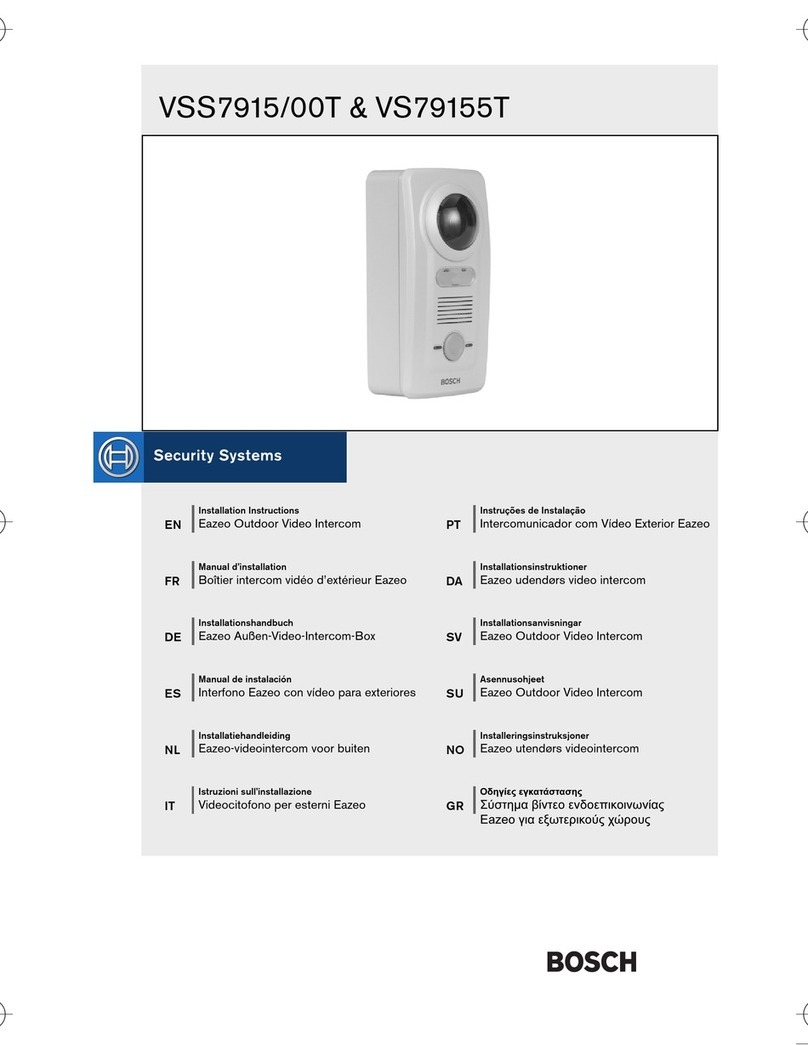
Bosch
Bosch VSS7915/00T User manual
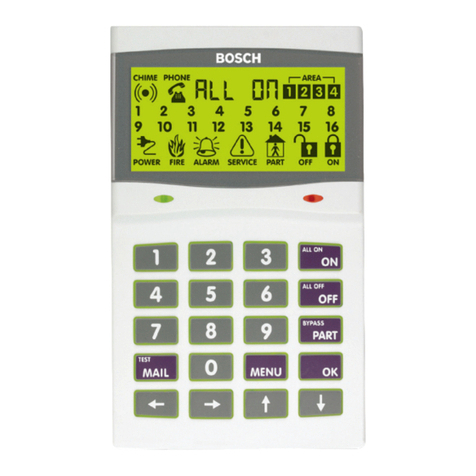
Bosch
Bosch Solution 16i User manual

Bosch
Bosch 7100 User manual
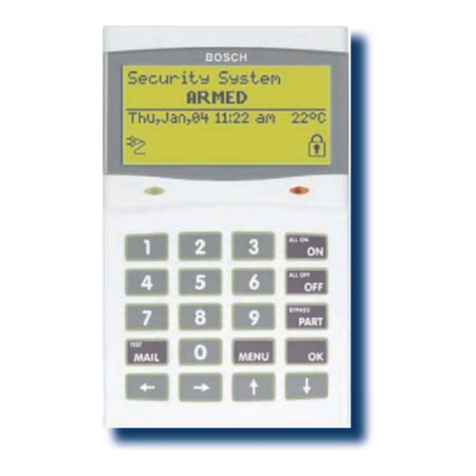
Bosch
Bosch Solution 64 User manual
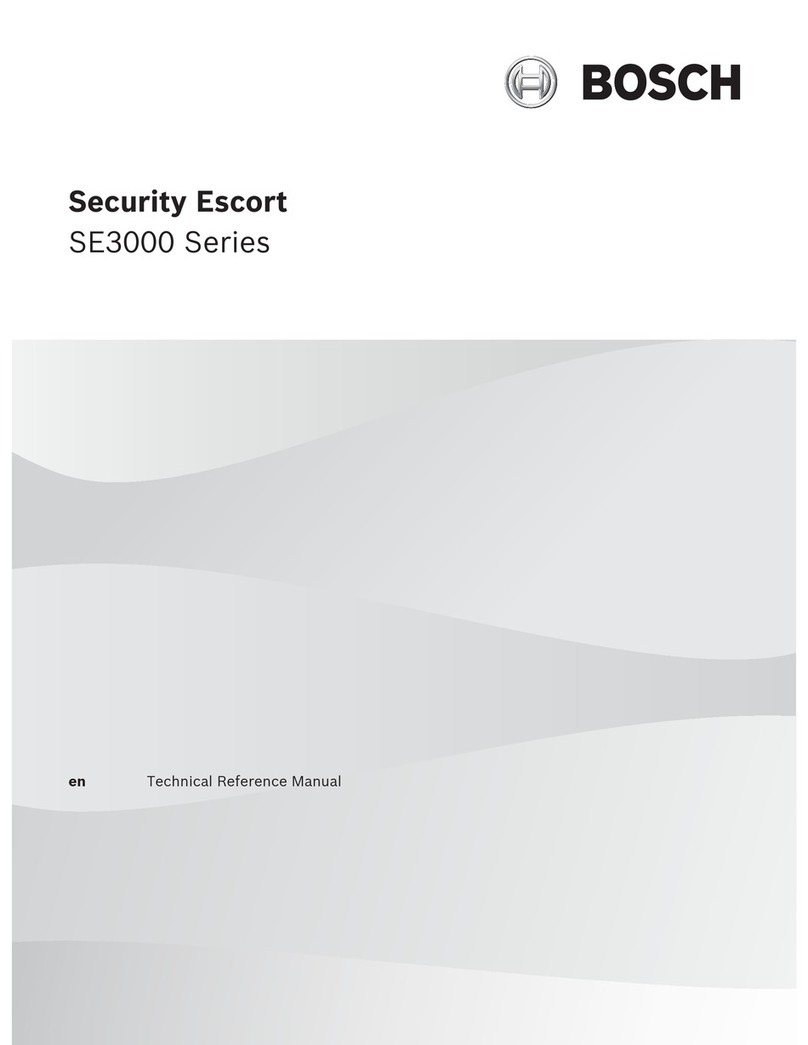
Bosch
Bosch SE3000 Series Product manual

Bosch
Bosch NBN-733 Mounting instructions

Bosch
Bosch LTC 8850 Series User manual
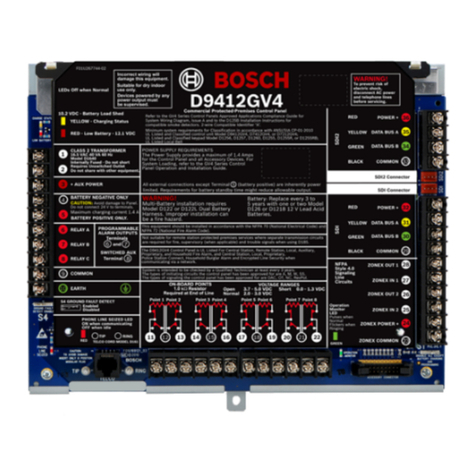
Bosch
Bosch D9412GV4 User manual
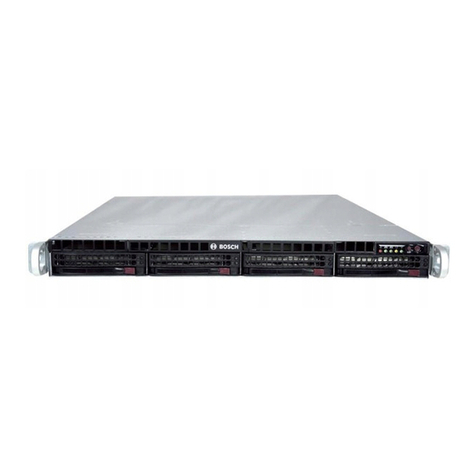
Bosch
Bosch DIP-7040-00N User manual
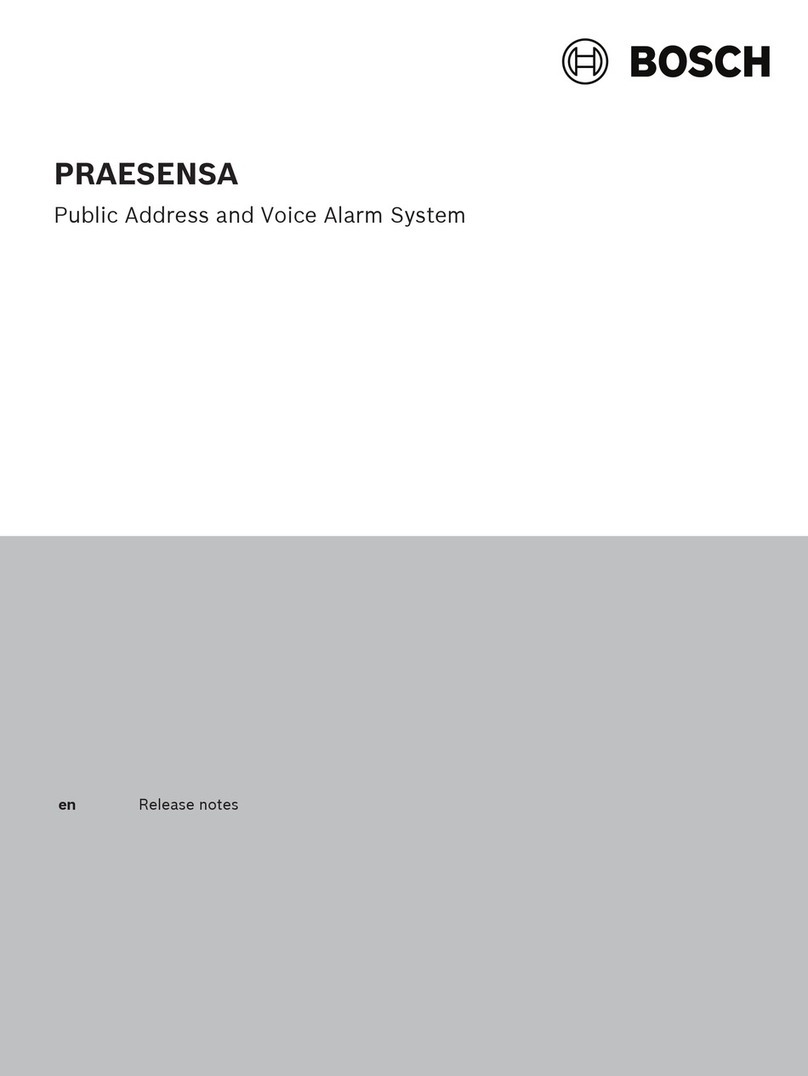
Bosch
Bosch PRAESENSA How to use
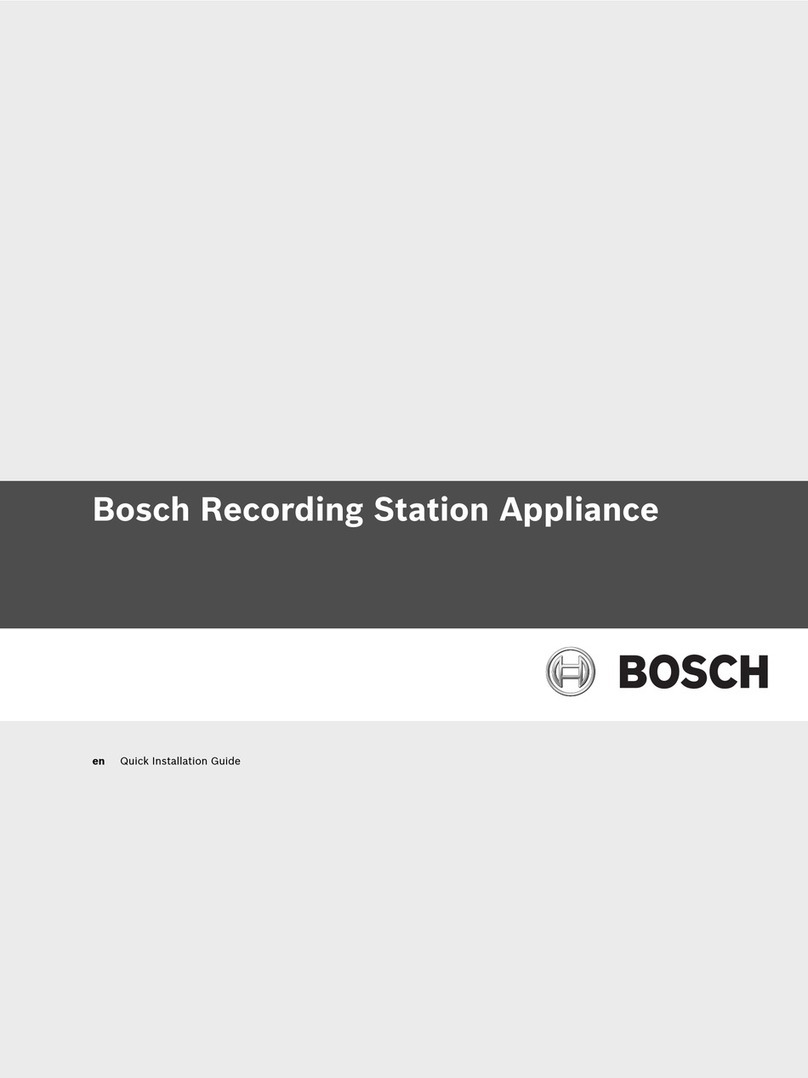
Bosch
Bosch BRS User manual
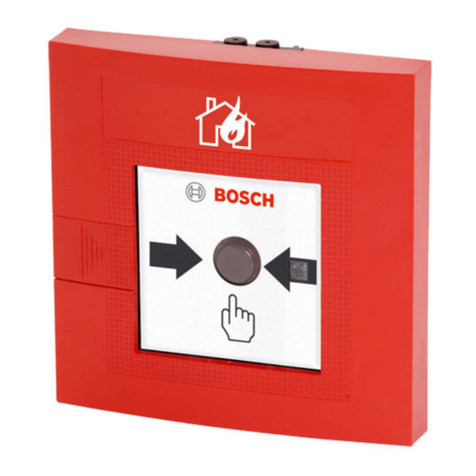
Bosch
Bosch 120 Series User manual
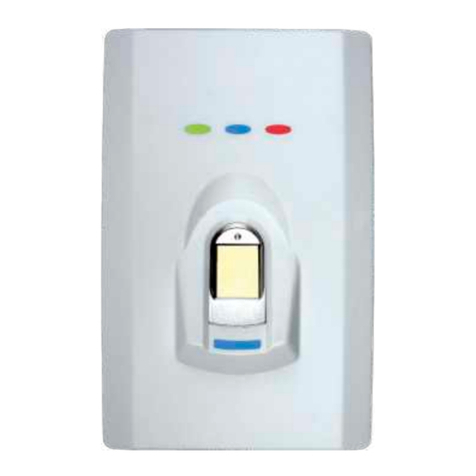
Bosch
Bosch CM728B How to use
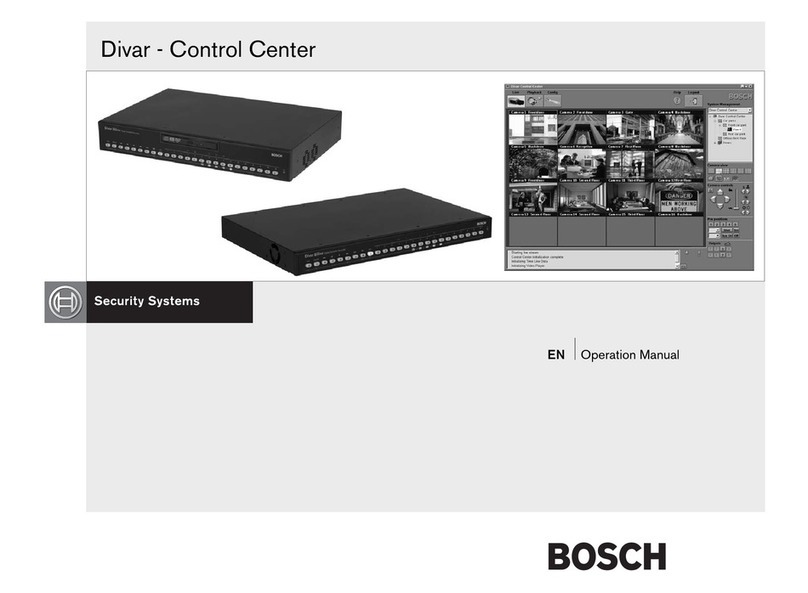
Bosch
Bosch Divar User manual

Bosch
Bosch FLM-420-RLE-S User manual

Bosch
Bosch Carephone 61 User manual

Bosch
Bosch SOLUTION 3000 User manual
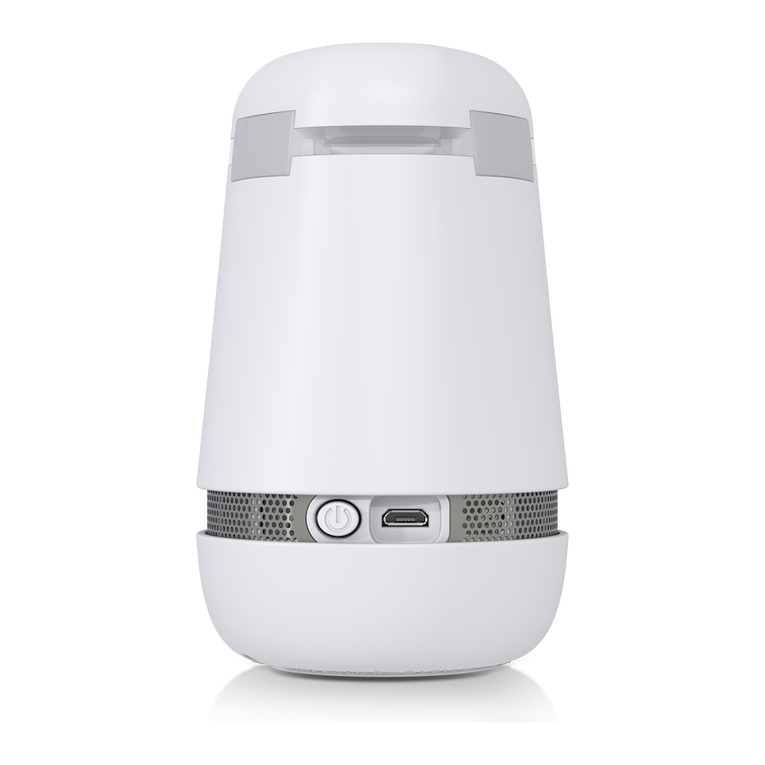
Bosch
Bosch Spexor User manual
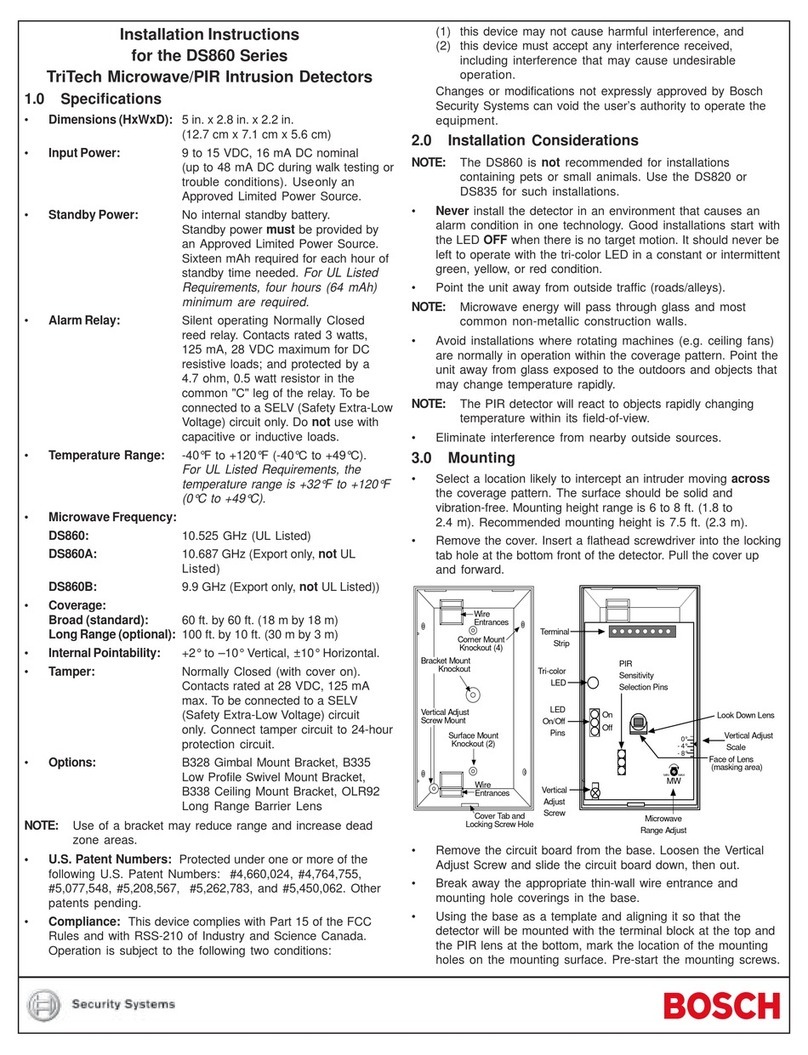
Bosch
Bosch DS860 Series User manual

Bosch
Bosch AMAX 2100 User manual
